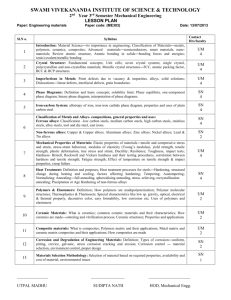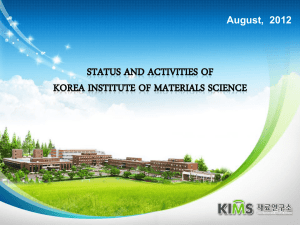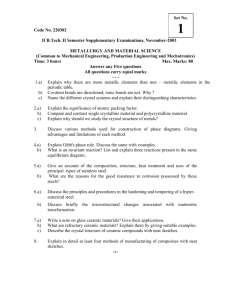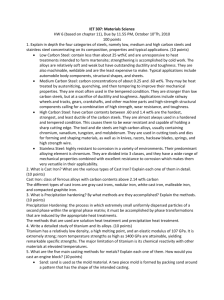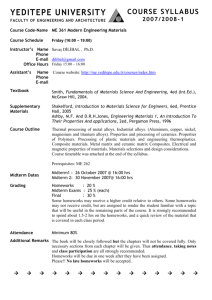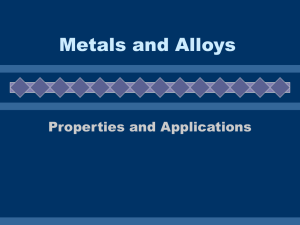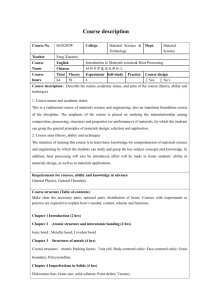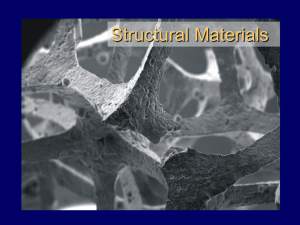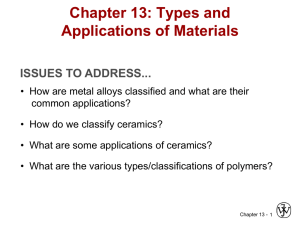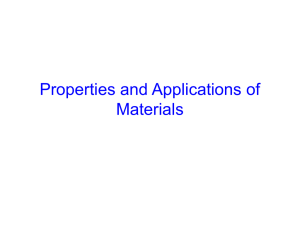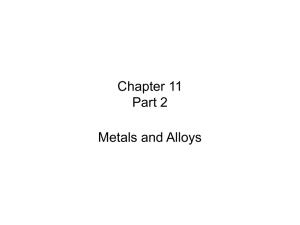2013
advertisement
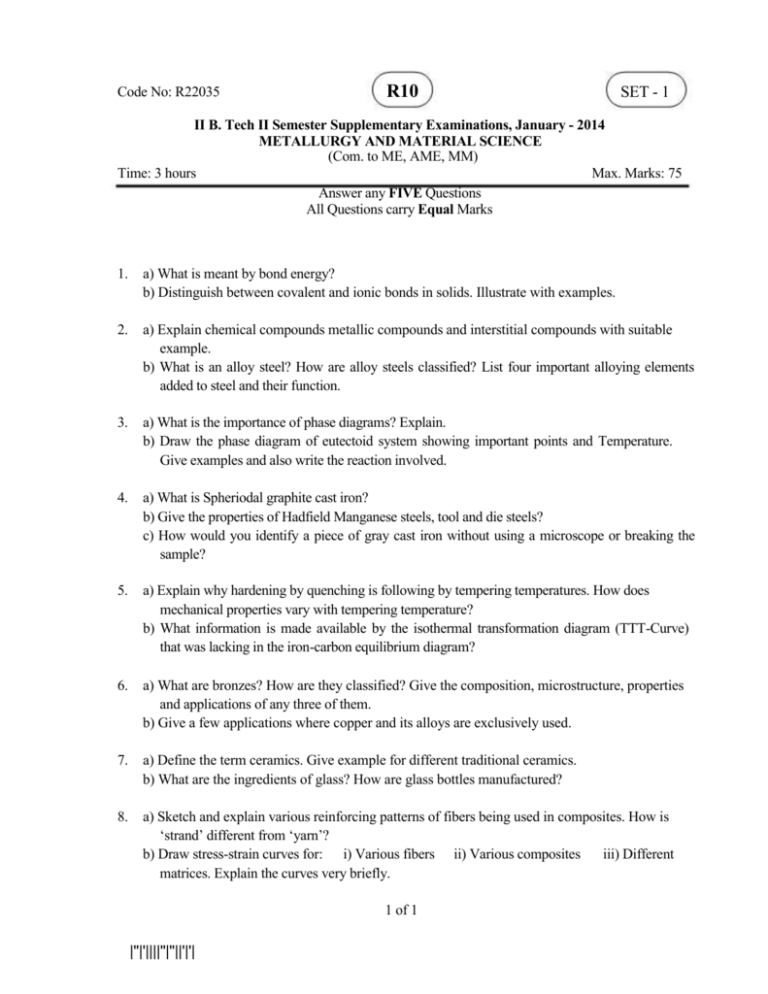
Code No: R22035 R10 SET - 1 II B. Tech II Semester Supplementary Examinations, January - 2014 METALLURGY AND MATERIAL SCIENCE (Com. to ME, AME, MM) Time: 3 hours Max. Marks: 75 Answer any FIVE Questions All Questions carry Equal Marks 1. a) What is meant by bond energy? b) Distinguish between covalent and ionic bonds in solids. Illustrate with examples. 2. a) Explain chemical compounds metallic compounds and interstitial compounds with suitable example. b) What is an alloy steel? How are alloy steels classified? List four important alloying elements added to steel and their function. 3. a) What is the importance of phase diagrams? Explain. b) Draw the phase diagram of eutectoid system showing important points and Temperature. Give examples and also write the reaction involved. 4. a) What is Spheriodal graphite cast iron? b) Give the properties of Hadfield Manganese steels, tool and die steels? c) How would you identify a piece of gray cast iron without using a microscope or breaking the sample? 5. a) Explain why hardening by quenching is following by tempering temperatures. How does mechanical properties vary with tempering temperature? b) What information is made available by the isothermal transformation diagram (TTT-Curve) that was lacking in the iron-carbon equilibrium diagram? 6. a) What are bronzes? How are they classified? Give the composition, microstructure, properties and applications of any three of them. b) Give a few applications where copper and its alloys are exclusively used. 7. a) Define the term ceramics. Give example for different traditional ceramics. b) What are the ingredients of glass? How are glass bottles manufactured? 8. a) Sketch and explain various reinforcing patterns of fibers being used in composites. How is ‘strand’ different from ‘yarn’? b) Draw stress-strain curves for: i) Various fibers ii) Various composites iii) Different matrices. Explain the curves very briefly. 1 of 1 |''|'||||''|''||'|'| Code No: R22035 R10 SET - 2 II B. Tech II Semester Supplementary Examinations, January - 2014 METALLURGY AND MATERIAL SCIENCE (Com. to ME, AME, MM) Time: 3 hours Max. Marks: 75 Answer any FIVE Questions All Questions carry Equal Marks 1. a) Explain the principle of bond formation in solids, with a suitable example. b) How will you determine the size of the grain? 2. a) Describe the importance of Hume-Rothery Rules in the development of alloys. b) What are the three most common intermediate alloy phases? Explain any two of them. 3. a) How do you classify the phase diagrams? What are objectives of phase diagram? b) Write the peritectoid reaction. Draw a labeled phase diagram showing this reaction. Also give examples. 4. a) Name the various types of cast iron and discuss their properties and uses. b) Give at least four advantages of maraging steels as compared to regular stainless steels. 5. a) Define the term heat treatment and explain why are the steels heat treated. b) Write short notes on: i) Age hardening and ii) Stress relieving. 6. a) Explain Alpha and Alpha-Beta Alloys of Titanium. b) Titanium is very costly metal today. Can you justify its high cost and give a few typical applications of metal. 7. a) What are ceramics? Why do they possess high hardness, brittleness and high melting points? b) What are the important characteristics of ceramics? c) Name a few ceramic materials which are used in industry. 8. a) Explain the classification of composite materials. b) What do you understand the fiber reinforced materials? Explain with suitable example. 1 of 1 |''|'||||''|''||'|'| Code No: R22035 R10 SET - 3 II B. Tech II Semester Supplementary Examinations, January - 2014 METALLURGY AND MATERIAL SCIENCE (Com. to ME, AME, MM) Time: 3 hours Max. Marks: 75 Answer any FIVE Questions All Questions carry Equal Marks 1. Discuss the various mechanisms of strengthening of metals and alloys. 2. a) Why is alloying done? Explain why alloys find more applications than pure metals. b) What is a solid solution? What factors do control the solubility of elements? 3. a) Define the following terms: i) System ii) Component iii) Solubility limit and iv) Phase b) What is an invariant reaction? List and explain three reactions present in the Fe − Fe3C equilibrium diagram. 4. a) Explain the properties and engineering applications of the following: i) Low carbon ii) Medium carbon iii) High carbon Steels. b) Which stainless steel is best suited for surgical instruments? Explain. 5. a) What is the purpose of tempering? Explain briefly the theory of tempering. b) Steel is made hard by quenching. List at least three conditions which must be fulfilled to justify the above statement. 6. a) What is the structure and properties of copper and its alloys. b) What is meant by anodizing of Aluminum? Explain. 7. a) Compare the physical, chemical and mechanical properties of ceramics with those of metals. b) What is Portland cement? How does it differ from white cement? 8. a) What are composite materials? Explain with examples and what do you understand by the fiber reinforced materials? b) Explain briefly the metal-matrix composites and Carbon-Carbon composites 1 of 1 |''|'||||''|''||'|'| Code No: R22035 R10 SET - 4 II B. Tech II Semester Supplementary Examinations, January - 2014 METALLURGY AND MATERIAL SCIENCE (Com. to ME, AME, MM) Time: 3 hours Max. Marks: 75 Answer any FIVE Questions All Questions carry Equal Marks 1. a) Describe Covalent bond formation with a suitable example. b) Define grain growth and enumerate the factors on which it depends. 2. a) What is an alloy? How many components are found in an alloy? Give a few examples of alloys. b) Explain substitution and interstitial solid solutions with neat sketches. 3. a) What is eutectic reaction? How does it differ from a eutectoid reaction? b) Derive the Lever law as applied to equilibrium diagrams? 4. a) What is cast iron? How does it differ from pig iron? b) Explain the following types of malleable cast irons. i) Ferritic malleable cast iron ii) Pearlitic malleable cast iron. iii) Ferrito-Pearlitic malleable Cast Iron. 5. a) What is annealing? Differentiate between Process annealing and recrystallization annealing. b) Define and explain Hardness and Hardenability. 6. a) What is brass? Describe the composition, properties and uses of brasses. b) What are the advantages of aluminum alloys over other alloys? Where are they used? c) Explain briefly phosphor bronze. 7. a) What are structural ceramics? Discuss the important structural ceramics with examples and applications. b) What are Refractory materials? State their basic properties and used. 8. a) What is a composite material? What are the ingradient of various FRP? b) Explain the following in detail: i) Matrix ii) Reinforcement iii) Interface and iv) C-C Composites. 1 of 1 |''|'||||''|''||'|'|
